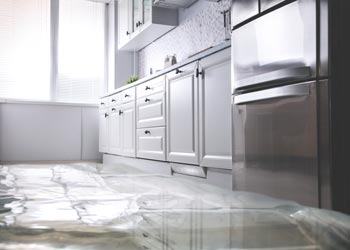How To Clean Up After Water Damage

Water damage to a home’s interior can happen from area flooding, malfunctioning appliances, or improper drainage around the home.
Regardless of the culprit, when water finds its way into places unintended, it can cause an array of issues ranging from structural damage to ruining furniture, carpets, memoirs, electronics, and more.
Water damage can happen with as little as an inch of standing water, becoming a breeding ground for mold.
The key to preventing mold and other issues is to act quickly. Because mold is a living fungi, it will begin cultivating quickly in any moist, warm environment, which not only threatens the integrity of your belongings, but it can also lead to illnesses caused by poor air quality. Emergency restoration is imperative!
What To Do After Water Damage
Check out the following suggestions for cleaning up after water damage:
#1 Shut Off The Power
If there are electrical outlets and/or electronic items in the affected area, before doing anything else, shut off the power. Your safety is more important than any items you own. Afterwards, unplug appliances and equipment, and remove from the area if possible.
#2 Remove Wet Items
The key to is getting the area completely dried out. Remove all items from the flooded area including furniture, rugs, carpets, and padding. Unfortunately, fabric and porous items are often unsalvageable after water damage, depending on how much water was absorbed.
#3 Dry The Area Out
Remaining water should be cleaned up with thoroughly using anything necessary including mops, buckets, and towels. Weather permitting, take advantage of natural sunlight, opening the windows and doors to increase air circulation. If electricity can be safely used and you have access to a wet/dry vacuum and/or dehumidifier, it will further deter mold.
#4 Disinfect All Surfaces
Flood water and water from plumbing issues are bacteria-ridden. So, once the floors, baseboards, dry wall, and other surfaces are thoroughly dried out, wash everything down with a disinfectant. Look for a disinfectant that kills mold and mildew, and if possible, opt for one that is non-toxic. Not only is it safer if inhaled, it is also more environmentally friendly.
#5 Dispose of Damaged Goods
When discarding unwanted or damaged items, recycle as much as possible. Granted, after cleaning up water damage and trying to resume normalcy in life can be difficult, but these extra steps benefit everyone. Your local government or waste management facility will be able to advise you on safely disposing of toxic liquids and cleaners, batteries and electronics, damaged items, and housing materials.
Additional steps to take:
During the cleaning phase, keep in mind that water can easily seep into crevices, the subflooring, and many other places you can’t see. Again, mold grows and spreads quickly, and is capable of destroying porous materials including wooden framing of a home. If there is any concern of remaining moisture, contact a mold remediation professional as soon as possible.
Aldo's Restoration & Construction provides emergency restoration services including water damage restoration throughout Charlotte, NC. We have extensive experience in remediation and work closely with insurance companies to get your home back in working order. Call us today at (704) 607-9783 or contact us here for a free estimate.

